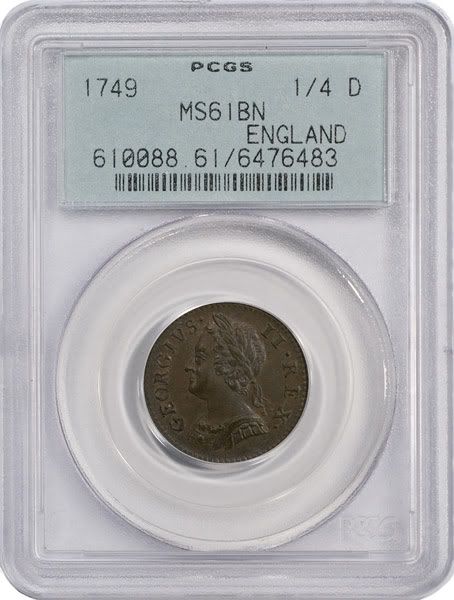Name a coin that isn't included in the Pre-Federal (Colonial and Post-Colonial) section of the Red B
 MidLifeCrisis
Posts: 10,561 ✭✭✭✭✭
MidLifeCrisis
Posts: 10,561 ✭✭✭✭✭
I'll start...
1749 British Halfpenny and Farthing.
Here's an excerpt from the University of Notre Dame Department of Special Collections website -
". . . in 1749 when the largest shipment of British coppers to be sent to the colonies arrived in Boston on the ship /The Mermaid./ The British parliament sent Massachusetts Bay almost twenty-one long tons of Spanish silver coins (653,000 troy ounces in 217 chests) as well as ten long tons of English coppers (in one hundred casks), in order to reimburse the Colony for the assistance it provided to the Lewisburg expedition on Cape Breton Island, Nova Scotia, during the French and Indian War. According to the Massachusetts Currency Reform Act of January 26, 1749 the total reimbursement was equivalent to £183,649 2s7 and 1/2d in British sterling. The coppers included over 800,000 halfpence and more than 420,000 farthings all dated 1749; approximately thirty percent of the entire mintage for the year."

1749 British Halfpenny and Farthing.
Here's an excerpt from the University of Notre Dame Department of Special Collections website -
". . . in 1749 when the largest shipment of British coppers to be sent to the colonies arrived in Boston on the ship /The Mermaid./ The British parliament sent Massachusetts Bay almost twenty-one long tons of Spanish silver coins (653,000 troy ounces in 217 chests) as well as ten long tons of English coppers (in one hundred casks), in order to reimburse the Colony for the assistance it provided to the Lewisburg expedition on Cape Breton Island, Nova Scotia, during the French and Indian War. According to the Massachusetts Currency Reform Act of January 26, 1749 the total reimbursement was equivalent to £183,649 2s7 and 1/2d in British sterling. The coppers included over 800,000 halfpence and more than 420,000 farthings all dated 1749; approximately thirty percent of the entire mintage for the year."

0
Comments
"Everything is on its way to somewhere. Everything." - George Malley, Phenomenon
http://www.american-legacy-coins.com
And what about the Russian coins that circulated in Alaska prior to
"Seward's Folly"?
TD
Worry is the interest you pay on a debt you may not owe.
"Paper money eventually returns to its intrinsic value---zero."----Voltaire
"Everything you say should be true, but not everything true should be said."----Voltaire
Ok, it's late and it doesn't take much to get me excited at the moment.
<< <i>Didn't virtually any copper, silver, or gold coin circulate in colonial America based on metal value? >>
Yes. And I guess that's what makes some inclusions a slippery slope. It's perhaps too difficult to figure out what to include even a brief summary of. I've dug Spanish, French, British, and American coins on colonial sites, which were struck for Ireland, Cayenne, and in Mexico City, not to mention tokens, and I even found a small eastern Roman coin (late 4th century) on a colonial site last spring, which might have seen been in circulation as a farthing back then.
A representative example of a counterfeit 2 reales should be included in the Redbook.
Some of these were likely made in the New York City area during colonial times.
They probably were accepted in circulation by the colonists because "two bits", also known as two reales, was a commonly used denomination.
The Philadelphia Mint coined quarters starting in 1796 as a replacement for the popular two reales.
Edited for spelling.
Coin Rarities Online
TD
<< <i>I even found a small eastern Roman coin (late 4th century) on a colonial site last spring, which might have seen been in circulation as a farthing back then. >>
Fascinating.
<< <i>Dave....is that piece german silver?
TD >>
I haven't had it tested, but I believe it to be.
Coin Rarities Online